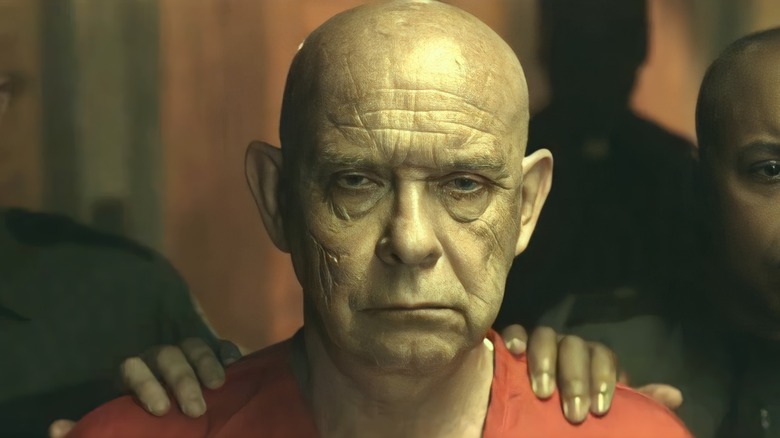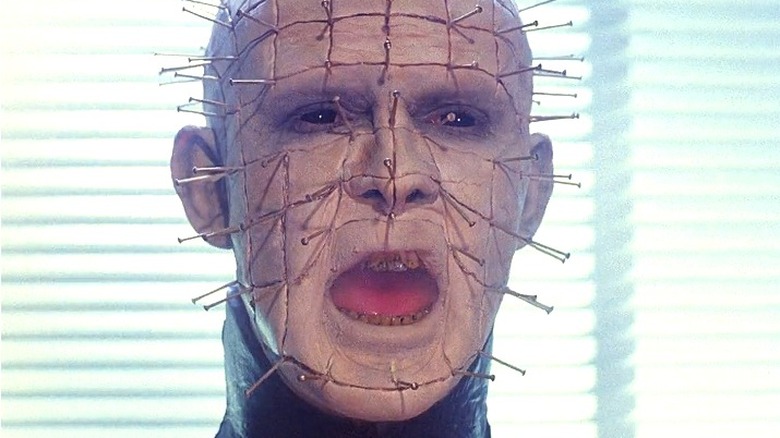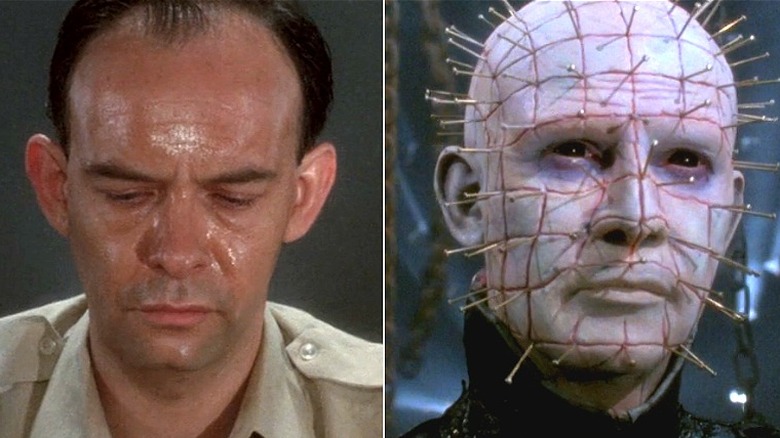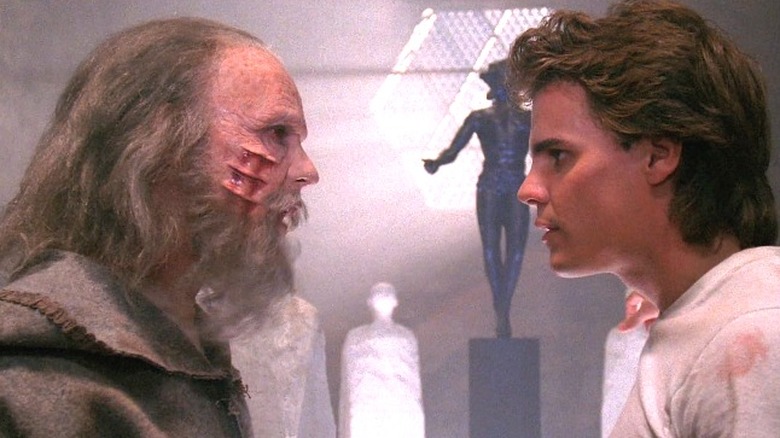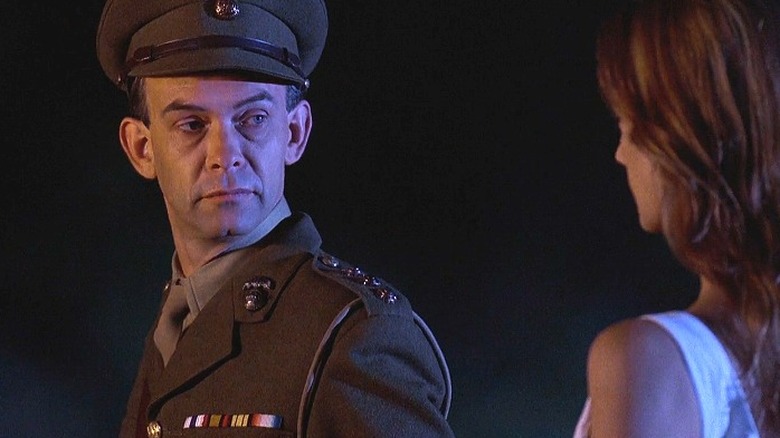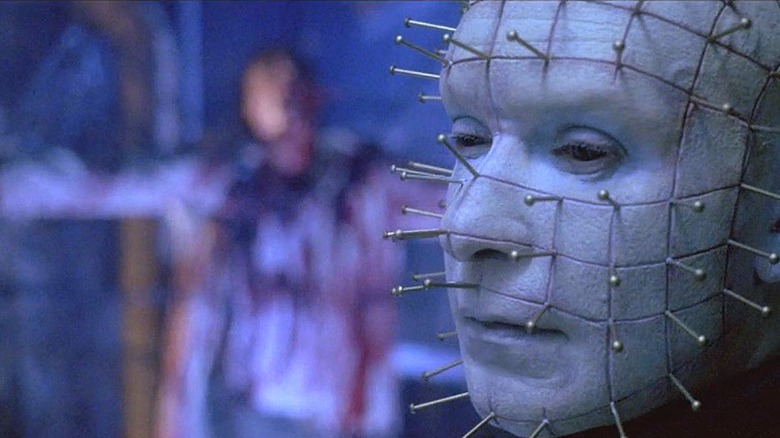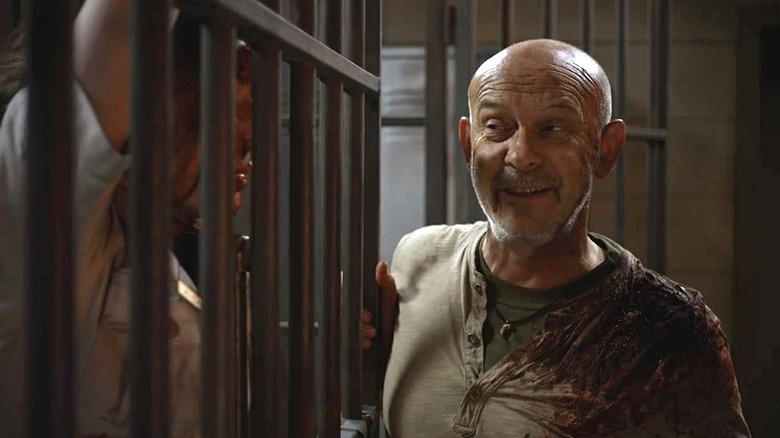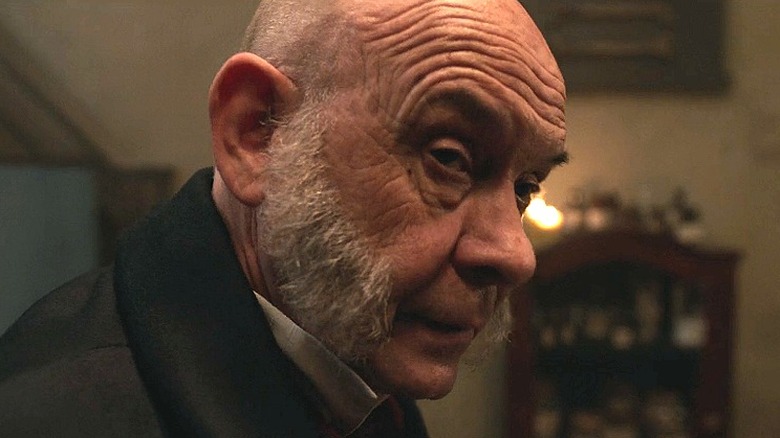Why Joe Chill From Gotham Knights Looks So Familiar
Despite its reliance on stock, teen archetypes created in the late 1980s, "Gotham Knights" has managed to go where no other Batman-less Batman series on the CW has gone before, by making Batman's murder — and the curious mystery thereof — the catalyst for its overarching narrative. In the half season since the case was thrust upon a ragtag bunch of young'uns comprised of petty thieves, GPA hot shots, and at least three superhero-supervillain nepotism babies, we've watched our intrepid heroes juggle a number of interconnected suspects, including an ancient Gotham crime syndicate called the Court of Owls and their steampunk ninja-bird assassins.
Sadly, "Gotham Knights" has yet to strike a proper CW balance between its dark setting and its Gossip-Creek-Hill teen melodrama, but that's not to say it hasn't given us some patently delightful moments. Sure, there's been plenty of telling instead of showing, plot gymnastics that defy credulity, and inconsistencies in tone, pace, and basic lighting, but ... there's also been some excellent casting. For instance: we first meet Joe Chill (as in, the presumed murderer of Batman's parents) in Episode 6, "A Chill in Gotham," and if the death row convict looks familiar to you — but also slightly "off" from how your brain is telling you he should look — it's because he's played by none other than Doug Bradley.
Yes, the Doug Bradley. And if that name doesn't instantaneously ring a bell, feel free to join us on a swift descent into the depths of his career. Come along, now. We have such sights to show you.
Doug Bradley was the face of Hellraiser
Bradley's big break — as the lead Cenobite (later known as Pinhead) in Clive Barker's "Hellraiser" — would turn out to be the definitive role of his now nearly four decade-long career in film and television. 10 sequels, prequels, and reboots later, it's easy to forget just how innovative and polarizing Barker's 1987 film truly was. But while Roger Ebert gave it a half star, The Los Angeles Times saw something else in Barker's adaptation of his own novella. "When Barker moves into his specialties," wrote the latter's Michael Wilmington, "the mingling of terror and perverse sexuality, the images of human or monster bodies stripped raw — he's flagrantly flaunting the taboos, demonstrating his sexual radicalism [...] working not only out of our fear of the dead, but taking it a step further: into fear of sex with the dead, and a kind of satanically escalated kink."
By the late 1980s, countless slasher films had poked and prodded at the era's sexual repression and anxiety by aligning promiscuity with death and exploring the disfunction of misogyny. But "Hellraiser" did a fair bit more than "poke," and a major element of its disturbing effectiveness came from the wince-worthy tactility of its nightmare-inducing visuals. Bradley's chilling, dead-eyed portrayal of the priest of pain was a career maker, but one that almost didn't happen. Ultimately, and fortunately, the character won him over. As Bradley told The Guardian, "There was no doubt in my mind that this unnamed guy with the pins in his head had a certain je ne sais quoi that a mattress-delivery guy didn't."
That je ne sais quoi — and Bradley's portrayal of it — would return to the big screen a year later.
Doug Bradley got to show his real face in Hellbound: Hellraiser II
In the franchise's first sequel, "Hellbound: Hellraiser II," audiences learn a little more about the Cenobite leader's backstory. A flashback tells us that Bradley's still nameless "guy with the pins" was once Elliot Spencer, a British military officer who unwittingly unlocked the mysterious puzzle box (or, Lament Configuration) in WWI, and was doomed to enforce the ruthless rules and regulations of its demented dimension. In Bradley's second feature film, viewers get to see his pre-Cenobitian visage, and a glimmer of his former humanity. After Kirsty Cotton (Ashley Lawrence) reminds Spencer and his fellow Cenobites that they were all human once, Bradley's character sacrifices himself to the sequel's newly-transformed antagonist (Kenneth Cranham's Dr. Channard) in a bid to give Kirsty and her young charge Tiffany (Imogen Boorman) a chance to escape.
Barker didn't direct the franchise's first sequel, but he did write the story, and it shows. Unlike so many of the sequels yet to come, "Hellbound: Hellraiser II" has a firm grasp on the themes, transgressions, and taboos the author and illustrator sought to explore in "The Hellbound Heart," and is largely considered (prior to David Bruckner's reboot) the best sequel in the entire "Hellraiser" franchise.
Following this, Bradley teamed up with Barker in another of the latter's self-directed adaptations — a box office flop that would go on to become, like so many other cherished horror films, a cult classic.
Hellraiser wasn't Doug Bradley's only Barker adaptation
In 1990, Barker adapted and directed "Nightbreed," based on his novel "Cabal." In the film, he cast Bradley as another kind of underworld leader, and though his third film once again called for the actor to be heavily and unnervingly made-up, his sympathetic performance — and the film's own "misfit" journey — helped propel the actor to the horror icon he is today.
In Barker's novel, monsters (or, Nightbreeds) inhabit a place called Midian, a world that tortured protagonist Boone both dreams of and fears, which leads him to seek psychiatric help. In Barker's story, the land of misfits and outcasts isn't nearly as evil as "normal" society, where a serial killer psychiatrist convinces his patient (Boone) that he's responsible for the mad doctor's crimes. Unfortunately, 20th Century Fox failed to understand "Nightbreed" as an investigation of othering, or a commentary on the arbitrary and inaccurate distinctions we make between man and "monster" — and so, the film was marketed as a typical slasher, and suffered for it. As Den of Geek's Marc Buxton writes, "'Nightbreed' has more in common with an R-rated 'X-Men' than it did with Michael Myers or Jason Voorhees. 20th Century Fox buried the lede of their own film, and box-office failure was assured."
Luckily, the devotion of fans led to the release of a director's cut over two decades after its initial release. Meanwhile, Bradley's portrayal of Midian's leader, Dirk Lylesberg, is an interesting statement on his character in "Hellraiser." Both are, and aren't, "monsters" ... though in the "Hellraiser" sequels to come, meaning and theme would often take a backseat to repetitive, if occasionally imaginative, shock and gore.
Doug Bradley returned to Hellraiser in the '90s
Throughout the 1990s, Bradley would appear briefly in a handful of television series and several TV movies, shorts, and smaller, independent films, but his reprisal of Pinhead is his most well-known project from the era. Barker neither wrote nor directed 1992's "Hellraiser III: Hell on Hearth," though it's often lauded as one of the more viable sequels because it stays true, as The Washington Post's Richard Harrington observed, to the author's guiding themes and architecture. The film revolves around Bradley's Pinhead — and his split from his human half, Captain Elliot Spencer — and as Harrington writes, "It's hardly a surprise that Bradley steals the film — [writer Peter Atkins] provides him with some great dialogue, to which the classically trained actor does justice."
And it was even less of a surprise when Bradley returned, in 1996, for "Hellraiser: Bloodline." Though Bradley's performance in "Hell on Earth" went a long way toward keeping it properly grounded in Barker's vision, nothing, it seems — not even a much higher budget and a bigger studio — could save "Bloodline" from signaling the franchise's arguably inevitable shark jump. The film was part space-age sci-fi, part period piece flashback, and all chaos.
Doug Bradley stayed with Hellraiser throughout the early 2000s
If you somehow missed Bradley in the 1980s and 1990s chapters of "Hellraiser," you still may have caught him, perhaps even accidentally, in the 21st century leg of the franchise. From 2000 to 2005, Bradley would reprise his role as Pinhead in four more installments in the franchise, none of which were written or directed by Barker. Scott Derrickson ("Black Phone," "Sinister") took the reins for 2000's "Hellraiser: Inferno," and is the saving grace many fans and critics — such as Den of Geek's Jack Beresford and Bloody Disgusting's Alex DiVincenzo — point to when distinguishing it from the pile of incoherent nonsense and waisted suffering that permeates so much of the franchise.
Bradley himself, however, wasn't a fan. "The only one that doesn't work for me is 'Inferno,'" he told Bloody Disgusting in 2016.
Bradley returned for 2002's "Hellraiser: Hellseeker" (the one with Dean Winters, where Ashley Laurence's Kirsty comes back), 2005's "Hellraiser: Deader" (the one that's barely a "Hellraiser" movie, because it wasn't, originally), and again for 2005's "Hellraiser: Hellworld" — the one with a baby Henry Cavill.
Doug Bradley has popped up in other horror franchises, as well
Though a large portion of Bradley's non-"Hellraiser" work isn't exactly what you'd call "mainstream," his portfolio is extensive, and has occasionally seen the prolific actor appear in other well-known horror franchises. In 2005, for instance, he appeared in Joel Soisson's "The Prophecy: Uprising," the fourth and penultimate installment in a film series about warring angels and demons defined largely by Christopher Walken's presence in the first three films. In it, Bradley stars as Laurel, a man possessed by a demon named Belial, who's hellbent on ending the ongoing war on his own terms.
A year later, Bradley appeared in "Pumpkinhead: Ashes to Ashes." Though the first "Pumpkinhead" enjoys a kind of cult status thanks to its elevated (if low-budget) use of atmosphere and folklore, the sequels have consistently failed to live up to the original. In "Ashes to Ashes," the third of five films, Bradley plays a local mortician who's been selling the organs of the towns' deceased rather than giving them proper cremations. As New York Magazine's John Leonard noted, the TV movie relied heavily on "That freak-show South existing only in the B-movie imagination where misbehaving characters out of Carson McCullers all suffer from inbreeding, pellagra, coprophilia, and hysterics." Bradley's next franchise project, 2012's "Wrong Turn: Bloodlines," relied on similar tropes.
In "Bloodlines" (not to be confused with "Hellraiser: Bloodline"), Bradley plays Maynard, patriarch of the franchise's murderous, in-bred, cannibalistic Odet family. The film, like most "Wrong Turn" movies after the initial sequel, was either ignored entirely or poorly received by those who saw it, and Bradley's believably unnerving portrayal of Maynard is its only real source of interest.
Six years later, the actor appeared in his most mainstream (non-Pinhead, non-franchise) role prior to Joe Chill.
Doug Bradley brought a historic monster to life in Lore
If you're not particularly familiar with "Hellraiser," Clive Barker, or B-horror franchises, it's possible you recognized the recent addition to "Gotham Knights" from Aaron Mahnke's "Lore." In the Season 2 premiere of the Amazon original — an anthology series based on Mahnke's "true lore" podcast — Bradley portrays the real-life Dr. Robert Knox, whose story goes something like this:
In early 19th century Britain, Knox was a widely-respected lecturer of anatomy and a celebrated zoologist and medical professional. Unfortunately (and deservedly), history would best remember him for the role he played in the infamous Burke and Hare Murders in Edinburgh. William Burke and William Hare were serial killers with a twist: they killed for profit, and Dr. Knox — who desperately needed cadavers in a time when cadavers were difficult to come by — was their main client. When the killers were eventually caught, Knox denied having any knowledge of his corpses' provenance, though it's far more likely that he simply looked the other way.
In "Lore," Bradley portrays Knox with calculated pragmatism and brazenness, as a man who clearly feels his own scientific ambitions outweigh any one individual's life (particularly if that individual is from the lower classes). Over the course of Bradley's career, he's played a number of despicable characters, but in his most notable and memorable, those characters have always been tied to a highly specific (often horrific, by most standards) code of morality. From the enforcer of Barker's perverse netherworld, to the face of skewed ethics in science, to the (innocent, according to "Gotham Knights") pawn in the Court of Owls game, the horror icon appears to be drawn to roles with more dimension (sometimes, more literal dimensions) than the average "monster."
